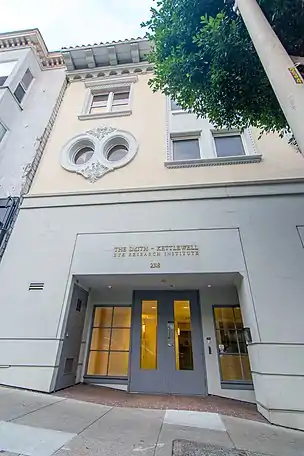
The Smith-Kettlewell Eye Research Institute is a nonprofit research institute in San Francisco, California, with a focus on vision science and rehabilitation engineering. It was founded in 1959 by Arthur Jampolsky and Alan B. Scott, when some members of Stanford University's Ophthalmology Department elected to stay in San Francisco rather than move to Palo Alto.[1]
Scientific contributions
The Institute did early experiments in sensory substitution, especially the substitution of tactile information for visual information to help blind people navigate[2] and other methods to obtain accessible technology.[3] This research is often performed by scientists who are blind, such as Josh Miele.[4]
The institute's use of botulinum toxin in humans as a therapy to treat strabismus. This initial therapeutic use led to later cosmetic use in Botox.[5] Other impactful work involved Anthony Norcia's study of vision in infants[6] and Erich Sutter's invention of the multifocal electroretinogram and of the multifocal evoked potential.[7]
The Institute has originated various visual illusions, including Christopher Tyler's development of autostereograms, and Anthony Norcia's coffer illusion.[8] Also popular are Tyler's analysis of the position of eyes in paintings,[9] of Mona Lisa's smile[10] and of Leonardo da Vinci's possible eye condition.[11][12]
Scientists
Over the decades, the Institute has hosted generations of vision scientists, including
- Paul Bach-y-Rita
- Laura Busse
- Matteo Carandini
- Julie M Harris
- Suzanne McKee[13][14][15]
- Ken Nakayama
- Anthony Norcia[16]
- Alan B Scott
- Erich Sutter
- Christopher Tyler
- Alan Yuille
- Joshua Miele
References
- ↑ "History | Smith-Kettlewell". www.ski.org. Retrieved 2021-02-17.
- ↑ Anwar, Yasmin (2014-07-01). "Blind lead the way in brave new world of tactile technology". Berkeley News. Retrieved 2021-02-17.
- ↑ Bogardus Cortez, Meghan (2017-03-10). "Accessible Technology Helps Students with Disabilities Pursue STEM Degrees". Technology Solutions That Drive Education. Retrieved 2021-02-17.
- ↑ Jamieson, Wendell (2013-03-02). "The Crime of His Childhood (Published 2013)". The New York Times. ISSN 0362-4331. Retrieved 2021-02-17.
- ↑ Vara, Vauhini (2014-11-18). "Billions and Billions for Botox". The New Yorker. Retrieved 2021-02-17.
- ↑ Weber, Bruce (1989-03-05). "WORKS IN PROGRESS (Published 1989)". The New York Times. ISSN 0362-4331. Retrieved 2021-02-17.
- ↑ Hood, Donald C (September 2000). "Assessing retinal function with the multifocal technique". Progress in Retinal and Eye Research. 19 (5): 607–646. doi:10.1016/S1350-9462(00)00013-6. PMID 10925245. S2CID 35169382.
- ↑ "Coffer Illusion | Best Illusion of the Year Contest". Retrieved 2021-02-17.
- ↑ Blakeslee, Sandra (1998-05-05). "In Painting Eyes, Artists Go Halfway (Published 1998)". The New York Times. ISSN 0362-4331. Retrieved 2021-02-17.
- ↑ Cohen, Philip (2004-06-23). "Noisy secret of Mona Lisa's smile". New Scientist. Retrieved 2021-02-17.
- ↑ Katie Hunt (2019-11-27). "Theory that Leonardo da Vinci's art was tied to rare eye condition refuted by new research". CNN. Retrieved 2021-02-17.
- ↑ Nina Avramova (2018-10-18). "Rare eye condition was behind da Vinci's genius, research claims". CNN. Retrieved 2021-02-17.
- ↑ "Suzanne McKee | Smith-Kettlewell". www.ski.org. Retrieved 2021-02-17.
- ↑ "VSS 2015 Davida Teller Award – Suzanne McKee". Retrieved 2021-02-17.
- ↑ McKee, Suzanne P. (15 September 2023). "Envisioning a Woman Scientist". Annual Review of Vision Science. 9 (1): 1–14. doi:10.1146/annurev-vision-111022-123844. ISSN 2374-4642.
- ↑ WIP (2012-06-03). "The Coffer Illusion Explained | What is Psychology? - Part 2". Retrieved 2021-02-17.